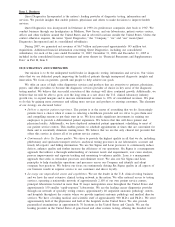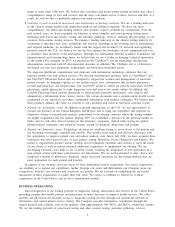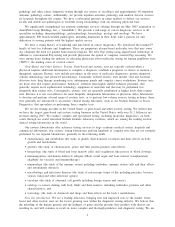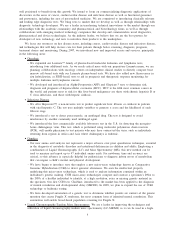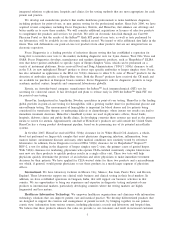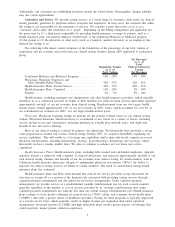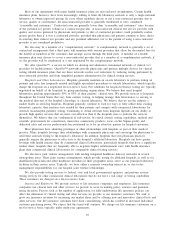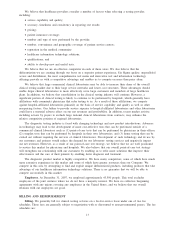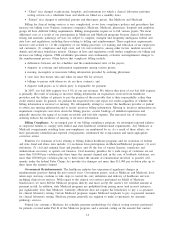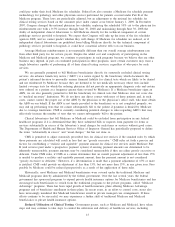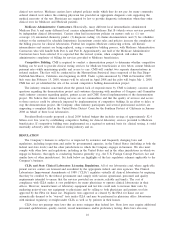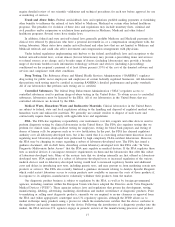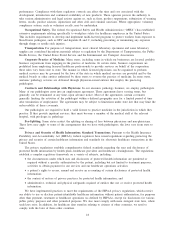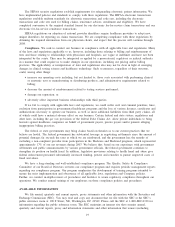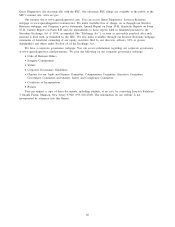Quest Diagnostics 2007 Annual Report Download - page 20
Download and view the complete annual report
Please find page 20 of the 2007 Quest Diagnostics annual report below. You can navigate through the pages in the report by either clicking on the pages listed below, or by using the keyword search tool below to find specific information within the annual report.Employers use clinical tests for drugs-of-abuse to determine an individual’s employability and his or her
“fitness for duty.” Companies with high turnover and safety conscious environments provide the highest volumes
of testing. Factors such as the general economy and job market can impact the utilization of clinical testing. We
seek to grow our employer volumes through offering new and innovative programs to help companies with their
goal in maintaining a safe and productive workplace. One of these innovations is our Blueprint for Wellness
program where we provide wellness screenings to employers and their employees.
GENERAL
Sales and Marketing. Our sales force is organized to focus on customer groups and service types. The
majority of representatives focus on marketing clinical laboratory testing, anatomic pathology and related services
to physicians, including physician specialists. Supporting our physician sales teams are genomics and esoteric
testing specialists, who are specially trained and focused on educating our clients on new and more complex
tests. In addition, we have a health plan sales organization that focuses on regional and national insurance and
healthcare organizations. We also have a hospital sales organization that focuses on meeting the unique clinical
testing needs of hospitals and promotes the specialized capabilities of our Nichols Institute esoteric testing
laboratories and our Focus Diagnostics infectious and immunologic disease testing laboratory. A smaller portion
of our sales force focuses on selling substance-of-abuse and wellness testing to employers. We also have a sales
force that focuses on selling risk assessment testing services to life insurance companies. In addition, we have a
sales organization that focuses on selling diagnostic products to hospitals, commercial clinical laboratories,
physician office laboratories, blood banks and clinics. We also have a sales force that focuses on our clinical
trials services to drug developers. We focus our sales efforts on obtaining and retaining profitable accounts. We
have an active customer management process to evaluate the growth potential and profitability of all accounts.
Information Technology. Information systems are used extensively in virtually all aspects of our business,
including clinical laboratory testing, test reporting, billing, customer service, logistics and management of medical
data. We endeavor to establish systems that create value and efficiencies for our patients and customers. The
successful delivery of our services depends, in part, on the continued and uninterrupted performance of our
information technology systems.
We have made substantial investments in our healthcare information technology systems, and believe that
they help differentiate us. Innovations in our healthcare information technology have the potential to improve
patient care, promote efficiency and reduce expense. Both at the federal and state levels, there are public and
private efforts to bring together healthcare providers, information technology vendors and other stakeholders to
facilitate the creation of standards for the exchange and use of electronic healthcare data, including standard
clinical code sets. If certain healthcare data and information technology standards were adopted, we could be
required to make substantial investments in our systems to comply with such standards or systems.
Our systems may be vulnerable to damage from a variety of causes, including telecommunications or
network failures, human acts and natural disasters. Moreover, despite the security measures we have implemented,
our systems may be subject to physical or electronic break-in attempts, computer viruses and similar disruptive
problems. We also have taken precautionary measures to prevent unanticipated problems that could affect our
systems. Nonetheless, system failures, such as those that interrupt our ability to process test orders, deliver test
results or perform tests in a timely manner, could adversely affect our reputation and result in a loss of
customers and net revenues.
Some of our historic growth has come through acquisitions and we continue to use non-standardized billing,
laboratory or other core information systems. We have standardized some of our systems and are implementing
standard laboratory information and billing systems across our operations, including those from our most recent
acquisitions. We expect implementation will take several more years to complete, and will result in significantly
more centralized systems, improve operating efficiency, provide management with more timely and
comprehensive information and enhance control over our operational environment. Failure to properly implement
the new systems could materially adversely affect our business. During system conversions of this magnitude,
workflow is re-engineered to take advantage of best practices and enhanced system capabilities, which may cause
temporary disruptions in service.
Quality Assurance. In our clinical testing business, our goal is to continually improve the processes for
collection, storage and transportation of patient specimens, as well as the precision and accuracy of analysis and
result reporting. Our quality assurance efforts focus on positive patient identification of specimens and reports,
proficiency testing, process audits, statistical process control and personnel training for all of our laboratories and
patient service centers. We continue to implement our Six Sigma and standardization initiatives to help achieve
our goal of becoming recognized as the undisputed quality leader in the healthcare services industry. In 1998, our
11


